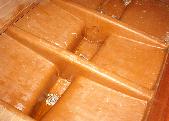As discussed earlier in this forum the boat is 20 years old and the general condition is indeed
the thing to look out for. All running rigging might have to be replaced soon and the same
goes for the deck-gear and engine. These are potentially very expensive upgrades.
We had a gallup here on the forum and most owners have experienced water-logged rudders.
The symptom is usually a wet spot on the stbd side of the blade, some 20 cm from the bottom.
This is the place where the blade has been filled with some kind of foam at the yard. The hole
has been filled with putty afterwards and this place along with where the rudderpost goes into
the blade are where it leaks. One owner reported a very strong construction inside the blade
but then again your mileage may vary, others have reported a different kind of "guts" inside
the blade.
There has been some talk about osmosis but at least the cases I've heard of are restricted to
between the very thick layer of gelcoat and has not penetrated into the glassfiber, yet.
If the engine is still the original seawatercooled one you would probably have to think about
doing something about it. We have an article about this here and there's another article in
Segling 8/2001. Although the article is about the YSE-series engine the same thing probably
goes for the GM as well, it's the head that corrodes the most. This part can be replaced,
a new head complete with valves and such costs about 500€+.
Earlier versions of the boat had "bottenstockar" that did not go down to the top of
the keel recess, later versions have a stronger type of construction. Here's a small
picture of the type of bottom we have:

One good indicator of a heavy grounding is if the boat has new "durkskivor", especially
in the after part of the cabin. Also look for cracked wood around the upper part of the
ladder. A heavy grounding would lift the bottom of the boat nearer the hatch, thus trying
to push the ladder up the hatch...
There has been some talk about the houdini front hatch leaking and dripping (especially
during rain) water on the front berth. In our boat it was the screws that where leaking, not
the hatch. We fixed this by replacing the screws with bolts.
There's a few. There are many more things to look for but none of these are catastrofic.
There is no real weak point in the boat as to my knowledge. No "röstjärn" ripping out of the
hull or keels swaying/dropping. It's a safe choice in my opinion, the biggest single
questionmark is the engine but since the boat is 20 yrs old you probably knew that already

As discussed earlier in this forum the boat is 20 years old and the general condition is indeed
the thing to look out for. All running rigging might have to be replaced soon and the same
goes for the deck-gear and engine. These are potentially very expensive upgrades.
We had a gallup here on the forum and most owners have experienced water-logged rudders.
The symptom is usually a wet spot on the stbd side of the blade, some 20 cm from the bottom.
This is the place where the blade has been filled with some kind of foam at the yard. The hole
has been filled with putty afterwards and this place along with where the rudderpost goes into
the blade are where it leaks. One owner reported a very strong construction inside the blade
but then again your mileage may vary, others have reported a different kind of "guts" inside
the blade.
There has been some talk about osmosis but at least the cases I've heard of are restricted to
between the very thick layer of gelcoat and has not penetrated into the glassfiber, yet.
If the engine is still the original seawatercooled one you would probably have to think about
doing something about it. We have an article about this here and there's another article in
Segling 8/2001. Although the article is about the YSE-series engine the same thing probably
goes for the GM as well, it's the head that corrodes the most. This part can be replaced,
a new head complete with valves and such costs about 500€+.
Earlier versions of the boat had "bottenstockar" that did not go down to the top of
the keel recess, later versions have a stronger type of construction. Here's a small
picture of the type of bottom we have:
[img]http://penti.org/~harald/bottenstockar-small.jpg[/img]
One good indicator of a heavy grounding is if the boat has new "durkskivor", especially
in the after part of the cabin. Also look for cracked wood around the upper part of the
ladder. A heavy grounding would lift the bottom of the boat nearer the hatch, thus trying
to push the ladder up the hatch...
There has been some talk about the houdini front hatch leaking and dripping (especially
during rain) water on the front berth. In our boat it was the screws that where leaking, not
the hatch. We fixed this by replacing the screws with bolts.
There's a few. There are many more things to look for but none of these are catastrofic.
There is no real weak point in the boat as to my knowledge. No "röstjärn" ripping out of the
hull or keels swaying/dropping. It's a safe choice in my opinion, the biggest single
questionmark is the engine but since the boat is 20 yrs old you probably knew that already ;)